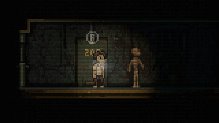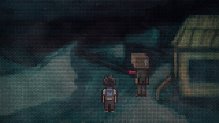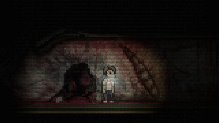Liverpool Sound and Vision Rating 9 out of 10
Lone Survivor: The Director’s Cut is a psychological survival horror adventure game available for download from the PlayStation Store for the PS4. The sub-title of the game is rather appropriate as this is an extended version of the cult indie game by Jasper Byrne, which was originally released in Europe on March 27th 2012 and America on April 23rd 2012 for the P.C., Mac and Linux with PS3 and Vita releases following on September 24th 2013.
The story revolves around a mysterious survivor who has survived the outbreak of a virus that is turning people into crazed monsters and zombies, which explains why the character is always wearing a surgical mask to ensure his protection from the virus, while searching for fellow survivors of the outbreak.
The path that players take through the game is pretty much up to them as they can stealthily place meat on the ground while a zombie has their back turned before entering a crawl space to lure any nearby zombies away from the line of sight before swiftly exiting the crawl space and making their way onto the next area or alternatively they can use a gun once they have attained it to shoot the zombies. As players are only given a gun after they have made their way around some of the zombies to a friends’ apartment, the game is started without any weapon of note and this provides a real sense of tension as initially there is only the choice of approaching the game stealthily, which somewhat results in the gun being a reward for the implementation of clever tactics to slip past enemies.
As players have to survive by themselves, they are always required to be on the look out for items that are beneficial to the survival of the character, resulting in there being all manner of items hidden around the environments being explored within cupboards, draws, lockers and fridges to collect and add to the inventory throughout the game from very early on. There is everything from pills to help aid sleep; food, tonics and drinks to supplement health; batteries to power a flashlight; diaries, letters and notes that tell the story from the perspective of people after the virus outbreak had begun; and many more items. Players will always want to ask themselves whether they really need to use any supplies to navigate a particular area or get past an enemy as the availability of provisions is rather scarce and players will not want to run out of any important supplies such as ammo, food or batteries, with the latter in mind, players should not want to have their flashlight permanently turned on as it will attract zombies to the location and as the flashlight is powered by batteries; the supply of such a commedity will drain much faster, resulting in some difficulty navigating the darker areas due to having no power available for this means of illumination.
Players have the freedom to influence the game from the beginning through to the very end with their actions, and if they do not manage their mental health appropriately, the characters can quickly descend into madness, alongside the importance of sleeping and eating well or resorting to drugs to keep you from collapsing. It is this sort of feature that further differentiates Lone Survivor from the competition as the fate of the character being controlled is totally up to the player and therefore creates a customisable experience that can be approached in a multitude of ways.
There are many improvements in the Director’s Cut in comparison to the original release of the game with new locations, side quests, dialogue, two new endings, an entirely new difficulty called expert mode and hundreds of new details that will be find throughout the game, alongside a greater amount of combinations for items, such as food, tonics, drinks and much more. One of the best overall improvements to the experience between the two versions is that the second playthrough of the Director’s Cut includes alternative conversations, paths, enemies and a completely different ending, which really adds a significant amount of replayability and provides a more than suitable reason to purchase the PS4 version; even if the original version is owned on P.C.
Lone Survivor possesses the best atmospheric tension in a videogame harking back to the survival horror era of the original Resident Evil trilogy on the PSOne. The original Resident Evil trilogy would make the heart pound with its unique brand of horror as players would always feel as though there was a zombie or monster around every corner and Lone Survivor is the one of the few rare games to have successfully captured that essence.
Lone Survivor: The Director’s Cut supported cross-buy and cross-save between the Vita and PS3 versions, although unfortunately cross-buy has not been extended to the PS4 version. This means that if the gamer already owns the Vita and PS3 versions, but want to play the PS4 version, you would have to purchase it again, although if players already own the Vita and PS3 versions, then the cross-save functionality allows synchronisation of the progression of the save file from the Vita or PS3 to the PS4 and vice versa, so the game can start to be played on the Vita on the way to and from work, sync the save game when return home and then resume where it was left off by loading the save game and continuing via the PS4 version. The cross-save feature is made possible by uploading the save file to the cloud on one console and downloading it from the other.
Lone Survivor: The Director’s Cut supports the share feature that allows players to upload a video clip or a screen shot to Facebook or Twitter and broadcast live gameplay footage via Twitch or Ustream as the game is being experienced with a simple tap of the share button and selecting the option of choice. The PS4’s hard-drive continuously stores the most recent fifteen minutes of gameplay footage, so players still have the chance to decide if they would like to share something amazing a few minutes after it has taken place. The share feature is a next-gen revolution that has only improved with the further customisation provided by the Share Factory app that allows commentary, music, themes, stickers, effects, text, picture-in-picture video between your game footage and your reaction from the PlayStation Camera and much more besides, which will only continue to prosper and flourish as it matures with additional features and further experimentation in the future.
The controls are relatively simplistic as they are well mapped to the DualShock 4 controller. The control scheme consists of pressing X to navigate through dialogue, selecting and navigating through your inventory and interacting with objects, pressing triangle to enter the inventory, pressing square to turn your flashlight on or off, pressing O to display the map, holding L1 enables the quick use mode and while holding L1 press square to use a flare, press triangle to eat meat, or press O drink a health tonic, holding R1 enables the gun mode and while holding R1, change the direction of the left analogue stick or press up or down on the d-pad to aim, press X to fire, or press O to reload, changing the direction of the left analogue stick or pressing left or right on the d-pad to move the character left or right and pressing up or down on the d-pad to face forwards or backwards or alternatively to navigate menus, pressing the share button takes players to the share feature menu, and pressing the options button to display the pause menu. The touch pad implementation provides a quick and effective method of adjusting the gamma by producing the gamma adjust menu, although you cannot adjust the gamma by swiping across the touch pad as you must use the left analogue stick or d-pad for that and there is no swiping navigation of the inventory, which is quite surprising. There is a much better usage of the light bar implementation as it produces multiple colours to represent the character’s current condition starting with green and gradually fading through various tones of yellow, orange and red, while the DualShock 4 controller vibrates when an enemy is attacking you.
The graphics now output in 1080P resolution on PS4 which is an improvement over the Vita and PS3 versions and have an overhauled lighting system in comparison to the original P.C. version, which is quite important considering how significant the lighting and darkness of a horror game must be as it is a necessity for them to be polar opposites from when the flashlight is turned on to when players are in total darkness to create the appropriate sense of tension, which is an art that Lone Survivor has certainly perfected. The graphics bring a retro inspired feel to the artistic style of the game in more than just the perspective of graphical effect, but perhaps as a throwback in the sense of how some of the best horror films were released yesteryear during the dawn of gaming, such as Halloween in 1978 and The Shining in 1980.
The presentation of the game is rather minimalist with navigation supported via the left analogue stick, d-pad and face buttons across the three options of the main menu including new game, continue and download from cloud, although it does not include support for navigation via the right analogue stick and touch pad. The background of the main menu helps to set the tone for what is about to follow as the camera scans across the screen from left to right as a dark mist descends in the foreground with buildings in the background.
The audio consists of sudden noises and climactic music that is rather appropriate to the subject matter as it creates a feeling of dread, tension and horror of what may be lurking around the next corner or in the darkness. The sound effects and music provide even more tension when the main character has been spotted by a zombie as it walks towards them with shrilling background effects acting almost as a siren for the player to get out of that area or draw the gun quickly. There is no DualShock 4 speaker implementation, which is surprising as it could have produced another layer of the atmospheric sound effects to increase the effectiveness of one of the main sources of tension in the game.
The trophy list includes 37 trophies with 18 bronze, 15 silver, three gold and one platinum trophy. All but five of the trophies are hidden as some of them are story based trophies related to the four separate endings of the game, while the rest are hidden somewhat for the sake of making the overall list harder to achieve that elusive platinum trophy without the use of a guide. The trophies are quite varied in their nature, ranging from eating a particular type of food that has to be found from scavenging the environment, combining it with something else from the inventory and cooking it in the appropriate manner, drinking certain drinks that players have to find from exploration, giving some of the food, drinks and comics collected to other characters, talking to a character a certain number of times, experiencing various dreams a certain number of occasions during sleep, and much more besides. It is estimated that depending upon the players imagination and creativity in regards to the approach of combining the inventory and the exploration of the game or a detailed trophy guide to provide some helpful tips that it would take around seven to ten hours to platinum the trophy list or as high as ten hours if players get stuck without a detailed trophy guide.
The expert mode is not that much different from the normal difficulty level as players will still have the same amount of health, your enemies will still deal the same amount of damage from their attacks, your enemies will also still have the same amount of health, and you will still get hungry and sleepy after the same duration in comparison to when you play in the normal mode. The only real difference is that you will receive less guidance, such as no indicators to inform players which buttons to press to perform actions or navigate through dialogue and menus and players will not be able to look at their map at any given time.
There are no local or online multiplayer modes, although Lone Survivor is not exactly the kind of game that would lend itself to supporting multiplayer, so that is no big loss to the gameplay. There are no online leaderboards, although a leaderboard for the best times for completing the game would have provided a competitive edge to the gameplay, but the lack of multiplayer and online leaderboards does not detract from the gameplay.
 Providing that players are brave enough to keep on playing it; the replayability of Lone Survivor: The Director’s Cut is astounding with four endings and all-new improvements that genuinely build upon the foundations of the original version of the game and take it to an entirely new level. That is not to say that the original was poor, as it certainly was not, but that the Director’s Cut is generally that much better due to the nine months of effort that Jasper Byrne and the team at Curve Studios have invested in adding a huge amount of new content and refinements to build upon the original P.C. version, while endeavouring to make a great game even superior in comparison to the P.C. version.
Providing that players are brave enough to keep on playing it; the replayability of Lone Survivor: The Director’s Cut is astounding with four endings and all-new improvements that genuinely build upon the foundations of the original version of the game and take it to an entirely new level. That is not to say that the original was poor, as it certainly was not, but that the Director’s Cut is generally that much better due to the nine months of effort that Jasper Byrne and the team at Curve Studios have invested in adding a huge amount of new content and refinements to build upon the original P.C. version, while endeavouring to make a great game even superior in comparison to the P.C. version.
Overall, Lone Survivor: The Director’s Cut crosses the boundaries between survival and psychological horror as players will always feel as though there is a monster right around the corner that has to be stealthily navigated or killed, while players will have flashes of light and darkness upon the screen and whispers of audio that provide alarm in the form of tense psychological horror, rather than just providing some jump scares. The price point of £7.99 for a title with the quality and replayability of Lone Survivor is exceptional value and should be commended with a purchase.
Jason Bonnar
Analysis
- Title: Lone Survivor: The Director’s Cut
- Developer: Curve Studios/Jasper Byrne/Superflat Games
- Publisher: Curve Studios/Jasper Byrne/Superflat Games
- System: PS4
- Format: PSN Download
- Cross-Buy: No
- Cross-Play: Yes (Cross-Save)
- Players: 1
- Hard Drive Space Required: 215MB

